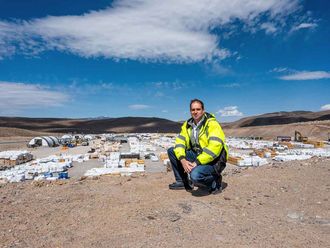Over the past few weeks, a lot of discussions within the tech industry have centred on the wave of digital transformation that is sweeping across the region.
There has also been a particular emphasis — not least in this column — on how it is now time for organisations to start experimenting with emerging technologies such as robotics, the internet of Things, and 3D printing, and evaluate how these innovation accelerators can be aligned with their overall business processes and strategies.
Unmanned aerial vehicles (UAVs) — more commonly known as drones — represent one such area that is ripe for experimentation. Drones have received considerable exposure over the last two to three years, firstly capturing the interests of hobbyists, then finding new use cases across several industries, and recently making their way into the news headlines. And here in the UAE, where the country is positioning itself as a regional hotbed for innovation, we have the annual ‘UAE Drones for Good Awards’.
UAVs are being put to a diverse range of uses across industries and countries, but they are proving particularly useful for monitoring purposes. Dubai Municipality’s Department of Waste Management is using drones to monitor landfills, which helps to reduce physical inspection times and lower the associated operational costs. At the same time, logistics companies across the Middle East and Africa (MEA) are either contemplating or already using drones to monitor their warehouses and shipments.
Drones are also being used to ensure infrastructure efficiency; for example, they can be deployed across oil rigs to check for leaks or used to assist in the inspection of transport networks. In the UAE, DEWA uses a wide variety of drones for monitoring, imaging, and detection purposes as part of its ‘Sirb’ initiative. Such use cases help organisations to prevent faults, improve their maintenance standards, and focus on other forms of innovation.
We are also increasingly seeing drones being used to bring about broader social and environmental benefits. In Africa, for example, UAVs are being employed in a surveillance capacity as part of concerted efforts to prevent poaching incidents, and there is the potential for drones to be used in the delivery of medication to remote parts of the continent. In Australia, meanwhile, coastlines are being monitored to prevent shark attacks on swimmers and surfers.
So, as we can see, drones are giving their users an uninhibited view into ecosystems that would otherwise be inaccessible — from jungles to oil rigs to vast coastlines. And they are increasingly being used by filmmakers, too, as they strive to secure evermore impressive footage and imagery. But the potential use cases for UAVs are limitless, and at IDC we are seeing a growing number of start-up companies across MEA utilise drones for innovative new applications.
The region has long encountered challenges in finding the right skills, and drones are helping out in this regard too. In Africa, for example, many countries are focused on transforming themselves into knowledge-based economies, and we are seeing a burgeoning middle class emerge as a result. This is inevitably driving parts of the population away from agriculture, and drones are helping to make up for some of the shortfall in skills.
There are, however, a number of safety, security, and privacy issues to consider when it comes to the use of UAVs. For example, there was a huge controversy last year in the US when a YouTube video appeared to show a gun being mounted onto a drone. This fuelled discussion on what should and shouldn’t be allowed when it comes to drones, and added to the ongoing debate around gun control in the country.
The imaging equipment that is typically housed on drones has also raised concerns around personal privacy and the potential for the information stored within them to be misappropriated by cybercrimals. And there is a pressing need for regulations to determine precisely which use cases require a commercial license and to govern exactly where hobbyists can and cannot fly their machines.
This was brought into sharper focus just last week when a British Airways flight collided with a drone on its approach into London’s Heathrow Airport. This follows on from an incident in January last year when air traffic at Dubai Airport was brought to a standstill for almost an hour as a result of people flying drones in prohibited airspace.
Despite these concerns, there is a clear opportunity for businesses from various industries to leverage the capabilities of UAVs in a bid to enhance operational efficiencies and drive cost optimisation. This use of drone technology will feed into the broader ‘internet of Things’, where the data gathered by UAVs will be analysed to enhance strategic decision making and enable the development of a responsive ecosystem.
As such, it is incumbent upon the relevant authorities to implement transparent and well-defined directives that not only help to foster innovation, but also enable this innovation to take place in an environment that is safe and secure for all involved. In the UAE, the General Civil Aviation Authority (GCAA) and Dubai Civil Aviation Authority (DCAA) have already established regulations that define acceptable use cases and prohibited areas for UAVs. It is now time for the wider region to follow suit.
— The columnist is group vice-president and regional managing director for the Middle East, Africa and Turkey at global ICT market intelligence and advisory firm International Data Corporation (IDC) He can be contacted via Twitter @JyotiIDC












